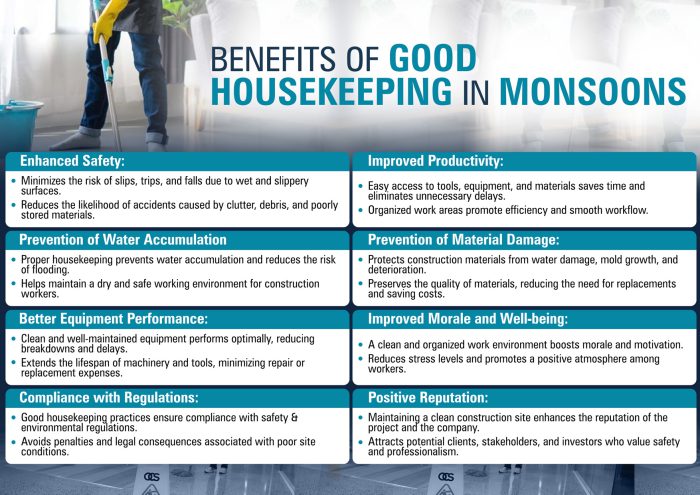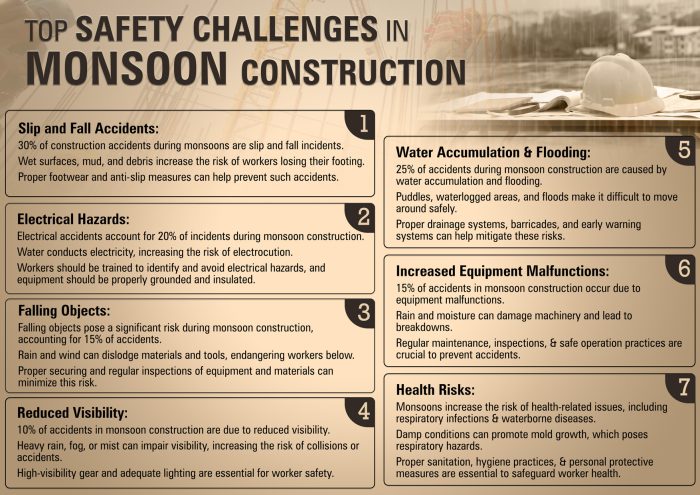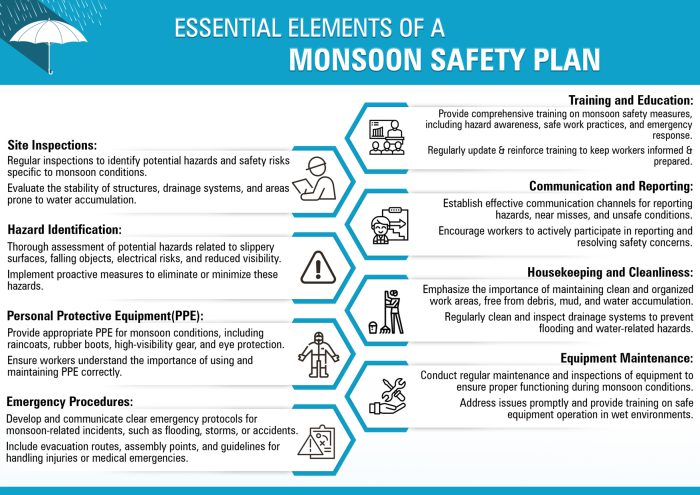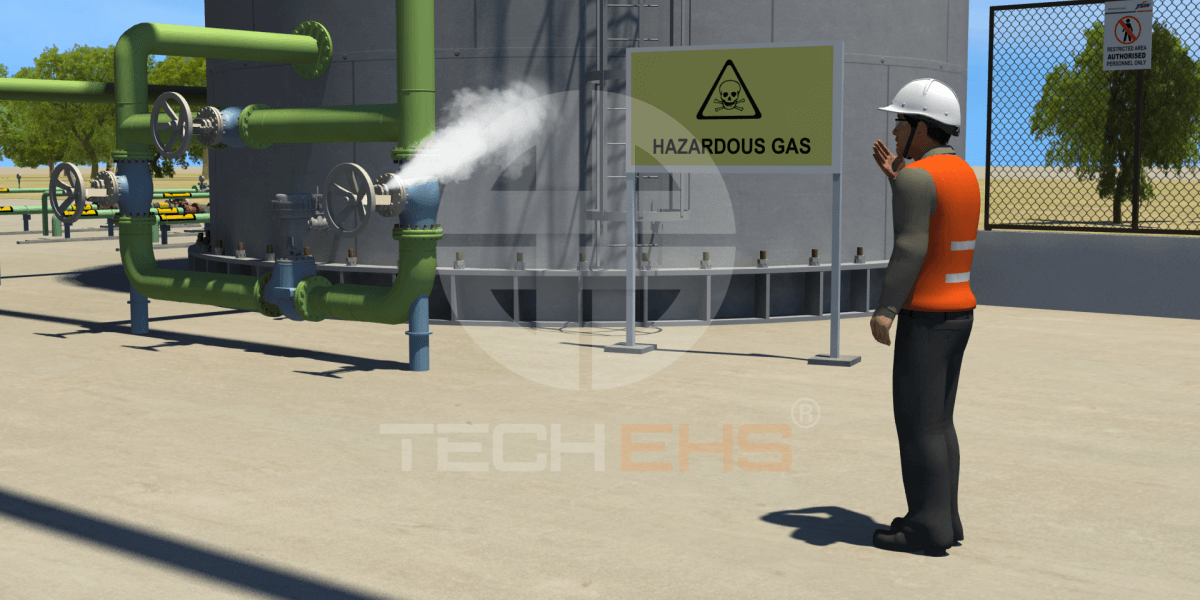
Table of Contents
- Introduction
- Understanding Rain Hazards in Construction: Risks Faced by Construction Workers
- Weatherproofing Strategies & Rain Safety Tips For Construction Sites
- Rain Safety Tips For Construction And Structural Inspections for Monsoon Preparedness
- Promoting Good Housekeeping
- Training and Education for Monsoon Safety
- Collaborative Efforts for Safety
- Environmental Impact and Sustainable Practices
- Best Practices from Real Projects
- Future Perspectives and Innovations
- Conclusion
- Frequently Asked Questions(FAQ)
Introduction
Ah! The rains are upon us!
The monsoon season brings much-needed relief from the scorching heat and poses unique challenges for construction sites. Heavy rains, strong winds, and slippery surfaces increase construction workers’ risk of accidents and injuries. As responsible stakeholders in the construction industry, we must prioritize the safety and well-being of our workers during this season. This blog will explore practical strategies and best practices to create a monsoon safety plan for construction sites and ensure that a monsoon preparedness plan is effectively implemented.
Weatherproofing Strategies & Rain Safety Tips For Construction Sites
Weatherproofing is a crucial aspect of ensuring worker safety during the monsoon.
Implementing protective measures for construction sites, such as covering open areas, securing loose materials, and reinforcing structures, can help prevent accidents caused by rain and wind.
Developing a monsoon safety plan for construction site workers is crucial to ensuring their well-being and mitigating potential risks during this challenging season. To create an effective monsoon plan for construction site, consider the following pointers:
Hazard Identification
Begin by conducting a comprehensive assessment of the construction site to identify all potential monsoon hazards. This includes slippery surfaces, flooding-prone areas, unstable structures, falling object risks, and electrical hazards. This step ensures that the monsoon preparedness plan addresses site-specific risks effectively.
Weather Monitoring
Keep a close eye on weather forecasts and monitor rainfall patterns during the monsoon season. This information will help you anticipate heavy rainfalls and plan your work schedule accordingly.
Personal Protective Equipment (PPE)
Provide appropriate PPE to all construction workers, including waterproof clothing, non-slip boots, helmets with face shields, and other gear necessary to protect them from monsoon-related hazards.
Training and Education
Educate workers about the risks specific to the monsoon season and rain safety tips construction. Conduct regular safety toolbox talk sessions to discuss rain safety tips and emergency protocols.
Site Preparation
Implement weatherproofing strategies such as covering open areas, securing loose materials, and reinforcing structures to minimize the impact of heavy rains and wind.
Drainage and Erosion Control
Ensure the construction site has a robust drainage system to prevent water accumulation and flooding. Effective erosion control measures should be part of the monsoon preparedness plan.
Regular Inspections
Conduct frequent inspections of structures, scaffolding, and equipment to identify and address any weaknesses or potential safety issues caused by rain hazards in construction.
Safety Message For Heavy Rain and Warnings
Install clear and visible safety signage throughout the construction site, warning workers of potential hazards and indicating safe routes during the monsoon.
Collaborative Efforts
Foster open communication and collaboration between contractors, site supervisors, and workers to share safety concerns, feedback, and ideas to improve the monsoon preparedness plan.
Protective Gear for Wet Weather
Outfitting construction workers with appropriate protective gear is vital during the monsoon season. Waterproof clothing, non-slip boots, and helmets with face shields can shield them from rain and potential hazards. Adequate rain gear can significantly improve worker comfort, visibility, and overall safety during their tasks.
Promoting Good Housekeeping
Slips, trips, and falls are common accidents at construction sites during monsoon season. To minimize these incidents, employers should ensure housekeeping hazards and control measures, such as walkways and work areas have adequate traction and are free from debris or water accumulation. Regularly inspecting and maintaining the site’s infrastructure and using warning signs can also help prevent such accidents.

Training and Education for Monsoon Safety
Education is a powerful tool in ensuring worker safety. Comprehensive training for construction workers on monsoon-specific safety protocols, emergency procedures, and the proper use of protective equipment can empower them to make informed decisions and respond effectively in challenging conditions.
Educational tools like animated videos and eLearning can significantly enhance worker safety training. By offering comprehensive training through these interactive mediums, construction workers can gain valuable insights into monsoon-specific safety protocols, emergency procedures, and the correct usage of protective equipment.
Animated videos can visually illustrate potential hazards and safety measures, making the training more engaging and accessible. eLearning platforms enable workers to access training materials conveniently, promoting continuous learning and reinforcing their knowledge. Empowering workers with this knowledge equips them to make informed decisions and respond effectively in challenging monsoon conditions, ensuring a safer working environment for all.
Collaborative Efforts for Safety
Ensuring worker safety in the monsoon is a collective responsibility. Contractors, site supervisors, workers, and management should collaborate closely to identify risks, address concerns, and implement safety measures. Encouraging open communication channels can lead to more effective safety solutions.
Environmental Impact and Sustainable Practices
Amid safety concerns, it is also essential to consider the environmental impact of construction practices during the monsoon season. Implementing eco-friendly monsoon preparedness plan strategies, such as rainwater harvesting and erosion control, can contribute to long-term sustainability.
Best Practices from Real Projects
Learning from successful case studies and real-life examples can be invaluable. Highlighting projects that effectively manage monsoon-related safety challenges can inspire others to adopt similar practices and foster a safer construction industry.
Future Perspectives and Innovations
Innovation significantly improves worker safety. Exploring emerging technologies, such as drones for site inspections and wearable safety devices, can enhance monsoon safety plan for construction site implementation. Being proactive in adopting new solutions will benefit workers and the industry.
Conclusion
The monsoon season demands heightened attention to construction worker safety. By understanding the hazards, implementing weatherproofing strategies, providing protective gear, and prioritizing preventive measures, we can create a safe working environment for construction workers. Regular safety toolbox talk sessions and a well-planned monsoon preparedness plan ensure that safety standards are maintained throughout the season.
Let us work together to ensure the well-being of our construction workforce, even in challenging weather conditions.





